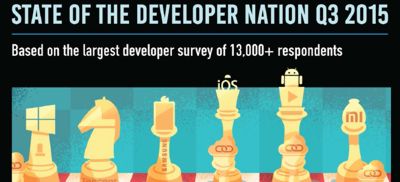| Cloud Apps Best For Revenue |
| Written by Janet Swift |
| Thursday, 06 August 2015 |
|
The latest State of the Developer Nation report has revealed that more than half of mobile developers and an even higher proportion of those developing IoT are making an income below the app poverty line.
Vision Mobile came up with the idea of the app poverty line in 2012 which revealed the bleak finding that one in three developers cannot rely on apps as a sole source of income, even if they have created multiple apps, see Survey Reveals App Poverty Line. Over successive Developer Economics reports the researchers have revealed interesting insights into the developer landscape, in particular the revenues models they employ and the income they achieve. The latest bi-annual report is based on a survey of more than 13,000 respondents, compared to just 1,500 back in 2012 and the findings about app poverty are still depressing. For the Q3 2015 report, Vision Mobile encompassed both professionals and those working on apps as a hobby or side project and distinguished between mobile, desktop, cloud services and IoT development, with 89% involved in two or more areas of development. Not all the developers who responded to the survey are interested in revenue but the proportions of developers in each income bracket in the following chart is of those who do want to see a financial return. The fact that between 15% and 27% of apps, depending on type, made no income at all is therefore bad news.
Vision Mobile sets the App poverty line at only $500 per month. Even so among the largest group, mobile, 51% of developers have revenues that fall below it. The report comments: A major cause of this is that most of them still persist in trying to make money via the simplest revenue models to implement - paid downloads and advertising. We have repeatedly reported on the way paid downloads are not working for developers. The vast majority of revenue through the app stores has been via in-app purchases for some time now and the percentage keeps increasing. Desktop is the second largest group and its revenue distribution is pretty similar to the previous group: Overall, desktop developers don’t do much better than mobile developers, with 49% falling below the app poverty line. This is unsurprising considering that their 3 most popular revenue models are the same as for mobile developers, except that contract work comes 2nd, with paid downloads 3rd, while the order is reversed on mobile. Working for hire is much lower risk than building your own products but not a route to riches. The outlier groups are IoT, which is worst with 59% below the app poverty line and Cloud, which is best with only 43% below it. The report makes an interesting point: This outperformance of cloud services developers is interesting because there must be some kind of client, be it mobile app, desktop app or IoT device. Since IoT developers are typically not making much money we can conclude that the mere presence of a cloud service connected to a mobile or desktop app is improving the odds of success. Selling physical products is a popular revenue model for both IoT and cloud apps but while the e-commerce model is working for cloud services, by way of royalties and licensing client software, the model hasn't yet taken off for pioneers into IoT. More InformationDeveloper Economics State of the Developer Nation Q3 2015 Related ArticlesSurvey Reveals App Poverty Line Revenue Models for Mobile Developers iOS Best For Making Money From Apps Revenue Generation For Mobile Platforms Global Mobile Developer Patterns Revealed
To be informed about new articles on I Programmer, install the I Programmer Toolbar, subscribe to the RSS feed, follow us on, Twitter, Facebook, Google+ or Linkedin, or sign up for our weekly newsletter.
Comments
or email your comment to: comments@i-programmer.info |
| Last Updated ( Wednesday, 21 October 2015 ) |




